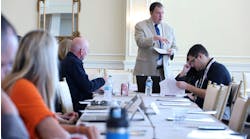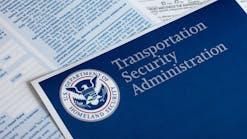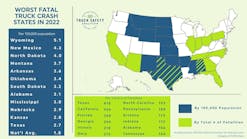Attorney, former OSHA council to USPS outlines steps to make next CSHO visit a more welcome experience
THE Occupational Safety and Health Administration (OSHA) means well. Created by Congress in 1970, the Department of Labor agency is charged with ensuring safe and healthful work conditions. But when OSHA’s at the door, it may feel more like a visit from a nosy in-law than a friendly neighbor.
“They think they’re helpful, but really you don’t want them in your house for too long, and sometimes you’ve got to take their advice with a grain of salt,” said attorney Trever Neuroth, an associate with the Washington DC office of Jackson Lewis and a former OSHA council to the US Postal Service.
To help companies prepare to receive their OSHA guests, Neuroth spoke about recent changes in OSHA reporting, including electronic record keeping and severe injury reporting, OSHA’s procedures after an injury report and tips on handling an inspection in “OSHA Happens: Injury Reporting Requirements & Inspections” during NTTC’s 2019 Safety & Security Council Meeting.
And, just like with your mother-in-law, it’s best to keep OSHA happy.
“One, compliance keeps you and your employees safe,” Neuroth said. “Two, non-compliance costs you money.”
Citations, revisions
Neuroth opened by sharing common OSHA citations, with the most prevalent in the last fiscal year under hazardous communication standards, followed by portable fire extinguishers, walking/working surfaces, guarding floor and wall openings and holes, permit-required confined spaces, recordkeeping, safety requirements for scaffolding, and machine guarding of mechanical power-transmission apparatus.
Employers with issues in these areas should pause here, then resume when they’re corrected.
Recently increased penalties include fines up to $13,260 per citation for serious, other-than-serious and posting-requirement violations; $13,260 per day, per citation for failure to abate a violation after the abatement date—and up to $132,598 per violation for willful or repeat citations.
“OSHA can really affect your bottom line if you’re not prepared,” Neuroth said.
Knowing what to record or report is paramount to proper preparation.
In 2015, OSHA established a rule requiring establishments with 250 or more employees to electronically report Forms 300, 301 and 300A, but after backlash from the business community, OSHA revised the rule in 2018 to only require electronic reporting of the 300A summary form each March.
“The reason they did that is there were a lot of complaints that supplying the 300s and 301s would give out personal identifying information about entered employees,” Neuroth said.
The 2018 revision also requires covered employers to provide their Employer Identification Number (EIN) as part of their electronic submission to the agency, with enforcement beginning March 2, 2020.
Reporting rules
Under new OSHA rules, work-related fatalities must be electronically reported—rather than simply recorded in a log—within eight hours of a work-related incident, or if death occurs within 30 days of the incident.
Serious work-related injuries, including in-patient hospitalizations of one or more people, amputations and loss of eye, must be reported within 24 hours of the event. So, if an amputation occurs 72 hours after the incident, it’s not reportable but still needs to be recorded in company logs.
OSHA defines in-patient hospitalization as formal admission to a hospital’s in-patient service for care or treatment, so a visit to the emergency room for observation or diagnostics is not reportable.
Exceptions to reporting injuries and illnesses include any fatalities or injuries occurring in a motor vehicle accident on a public street or highway, or while using commercial or public transportation.
“One thing to remember is, while you might not have to call OSHA and tell them about it, these injuries, if work-related, still need to be on your OSHA logs,” Neuroth said. “So there’s a difference between whether or not you have to record something or report it, and these exceptions only fall under whether or not the injury is reportable.”
When reporting, employers can dial OSHA’s 24-hour hotline at 800-321-OSHA (6742), call their local OSHA office or use an online form, which is the most common form of reporting and how Neuroth advises his clients report an incident so as not to draw undue attention to their facility.
Inspection categories
After receiving a report, OSHA can conduct an on-site inspection or send a rapid-response investigation (RRI) letter requiring the employer to perform their own accident investigation and submit results. Reports fall into one of three categories: on-site required, discretionary inspection or RRI.
In the first category, OSHA typically sends a Certified Safety and Health Official (CSHO), aka a compliance officer, if the injury reported involved a fatality, two or more employees were hospitalized, the injured employee is less than 18 years old, or if the employer is a repeat offender.
The second category, an inspection at the discretion of the area director, typically occurs when employees are still being exposed to the hazard, or if the incident is the result of failure in a safety program, and the third comes after a CSHO reviews an incident and determines the hazard is not still affecting employees, or the injury is not the result of a missing or insufficient program.
“(An RRI) is OSHA saying, ‘OK, we’re not going to send a compliance officer to you, but we’re going to ask you to essentially do what a compliance officer would do,’” Neuroth said. “They ask you to conduct an investigation, abate any hazards you find, and then post your response and send it to them.”
When an incident falls into one of the first two categories, and a compliance officer shows up at the facility’s door, the inspection typically begins with an opening conference, followed by a walk-around, document requests, employee and management interviews, and a closing conference.
So employers should have a logistical plan in place before OSHA arrives.
“You don’t want them entering from some other part of your worksite, and you don’t want to allow them to walk around (unescorted),” Neuroth said.
Opening conference
When first speaking to an officer, the company representative should establish the location for the inspection, guide them to the issue only, designate an interview area, like a manager’s office—not the workroom floor—and keep the officer in a designated area until they request a walk-around.
In an opening conference, a CSHO will explain the inspection’s purpose—if based on a complaint, ask to see the complaint to help narrow the focus—and outline terms. Union facilities should have a union rep on hand, and all employers should have five years of recordable OSHA paperwork available.
Interview requests must be reasonable, so if a company has 100 employees, the CSHO doesn’t need to speak to all of them. Provide a sampling, and set the duration and location for interviews. If an officer requests paperwork, have them put the request in writing, and if they take photos, video or samples, including noise samples, employers should take photos, videos and samples at the same time.
“What we did at the postal office was keep an OSHA tackle box with post-it notes, pens, pads and a camera,” Neuroth said. “That way whoever was running the inspection with the compliance officer could grab that tackle box and have everything they needed.”
OSHA interviews
Management interviews often give employers headaches, because they don’t want OSHA wasting managers’ time, so the key is to prepare in advance. Make sure managers and supervisors know the issues, anticipate likely questions, and understand lying can have serious consequences.
Statements from managers and supervisors are binding to the company, so they’re entitled to counsel. Typical ground rules Neuroth advises are no tape-recording, and no signing statements. If an officer takes notes during an interview, then asks the interviewee to review and sign them, it’s best to say no.
“We usually like to tell them, ‘No, these are your notes, this is not a statement, and I’m not signing that,’” Neuroth said.
Employee interviews are trickier because employees aren’t represented by the company. OSHA can request private interviews, but there’s no rule against an employer also interviewing employee witnesses. Remember, employee interviews are voluntary, unless OSHA has a subpoena, so employees can refuse to give them, but employers cannot bar employees from participating.
Let employees know OSHA has no right to record audio or video, or obtain a signed statement, but those activities are allowable, and do not encourage employees not to cooperate. Simply supply the facts, and make sure they understand participation will not adversely affect employment.
The best advice for employees in an interview, Neuroth said, is to tell the truth, only provide facts of which they have first-hand knowledge, don’t guess or speculate, listen carefully and only answer specific questions.
“One thing that OSHA’s really looking into the last few years is 11C (whistleblower) retaliation complaints,” Neuroth said. “So if you have an employee who participates in an OSHA inspection, you have to be very careful if you issue any discipline to that employee any time afterward.”
Final steps
Relay requested documents only through a designated representative, and only provide documents that are responsive to written requests. If the documents contain trade secrets, be cautious about providing them, and ask OSHA to keep them confidential. And never give OSHA “the keys to the cabinet.”
The closing conference is the time to extract information from the CSHO. Ask about any citations they plan to issue, how they will characterize issues (serious, other-than-serious, repeat or willful), what abatement is expected and how it is to be accomplished. If an employer quickly addresses the hazard, they might be able to settle any citations that show up later with an area director.
Never argue with the compliance officer or make admissions. Any citations will fall into one of several categories, including de minimis, which is a zero-dollar “heads-up” citation; other-than-serious, if the hazard falls under an OSHA standard but isn’t likely to cause serious injury; serious, where OSHA believes the hazard will cause injury or death; repeat, which follows past serious or other-than-serious citations; or willful, where OSHA must prove a hazard was purposefully disregarded.
Employers have 15 days from receipt of a citation to file a notice of contest. During that period, they can request an informal conference with an area OSHA director, which Neuroth advises because it’s another opportunity to gain information or try to settle a citation before it goes further. Failure to file a notice of contest is tantamount to admitting guilt and ends litigation.
If a notice is filed, the case is reviewed by a commission and assigned to an administrative law judge. Employers still can try to settle, but OSHA’s attorneys will be involved, complicating the process. If a settlement isn’t reached, the case goes to a hearing with the judge, and any adverse findings can be appealed to a three-person board, which determines the final outcome.
Inspection scenarios
Scenario 1: A compliance officer initiates an unannounced inspection but the company’s OSHA representative is unavailable. Can a front-office receptionist request that the officer return later?
That’s probably not a good idea, Neuroth said.
“The compliance officer might say sure, but when he comes back, I can almost guarantee he’ll have a warrant in hand,” Neuroth said. “So usually what we should do is train that first person to ask the CSHO to wait. While there’s not someone right there who can handle the situation, have that CSHO sit up in the manager’s office until someone can get there. And usually what you want to do is have at least a couple of people on-site who can be the lead for one of these inspections.”
Scenario 2: A compliance officer says in an opening conference he’s investigating an employee complaint regarding noise exposure in Area A. The officer then requests to view Area B. Is this allowable?
Under the plain-view rule, if the hazard in Area B is viewable from or en route to Area A, OSHA can inspect the new area. Employers can try to pick a path to Area A that circumvents Area B, but that can be tricky and isn’t a course Neuroth advises—since there shouldn’t be any issues anywhere.
Scenario 3: The officer states the only location at issue is Area A. While walking there, he notices a machine with a guard—a major issue for OSHA—in a different area. Can the officer head toward that area?
No, as there is no evidence the guard is causing a hazard. “The fact that machine-guarding is an issue for OSHA, and you have a machine guard, does not open the compliance officer to go search there,” Neuroth said. “Unless the compliance officer sees an issue with the guarding, they are not allowed to expand their search beyond the original complaint.”













